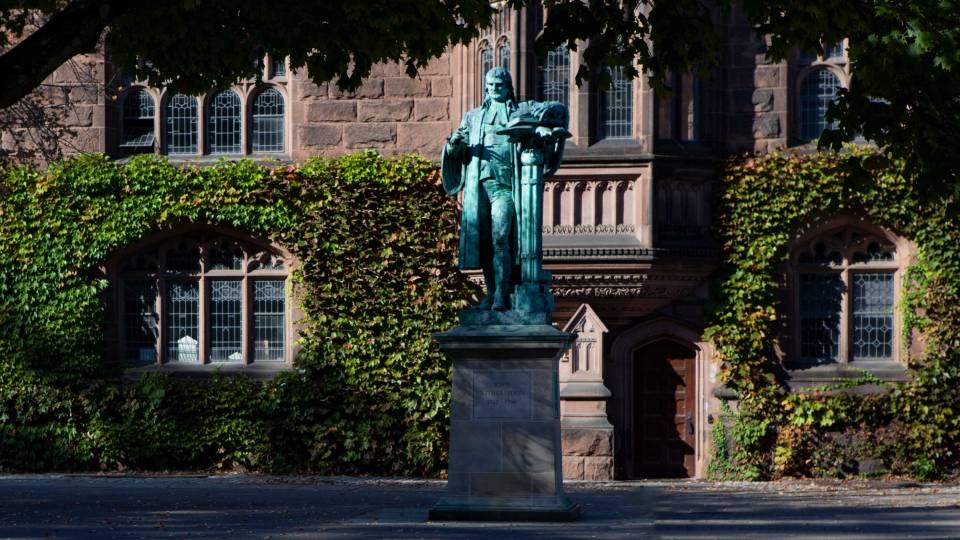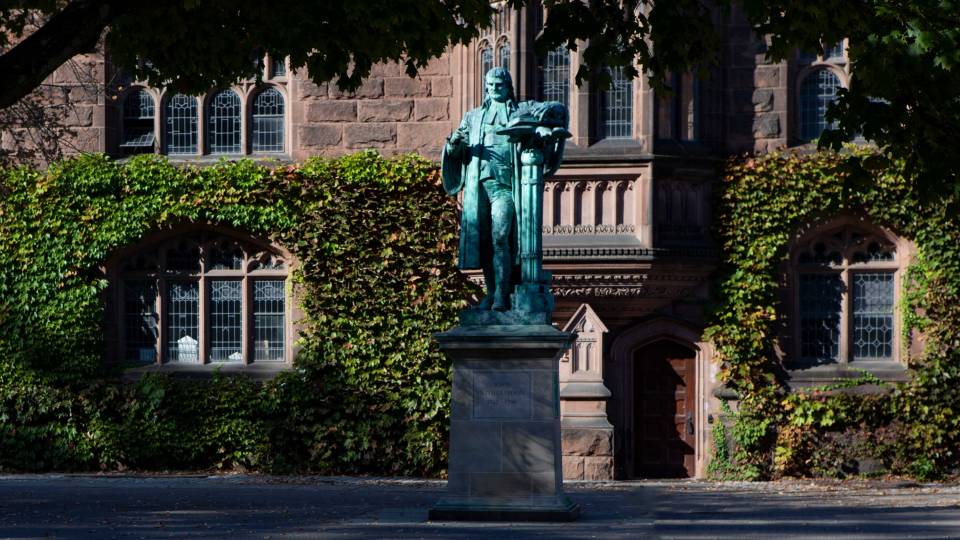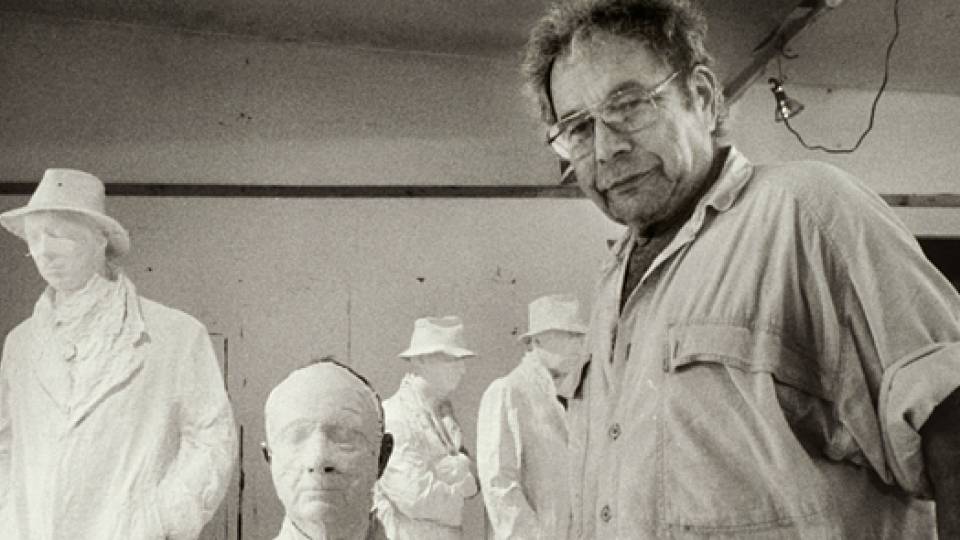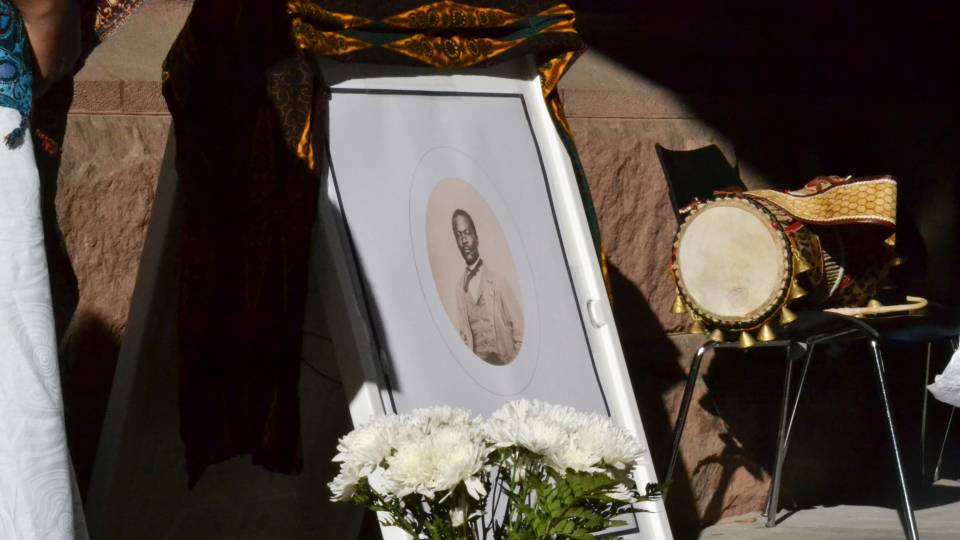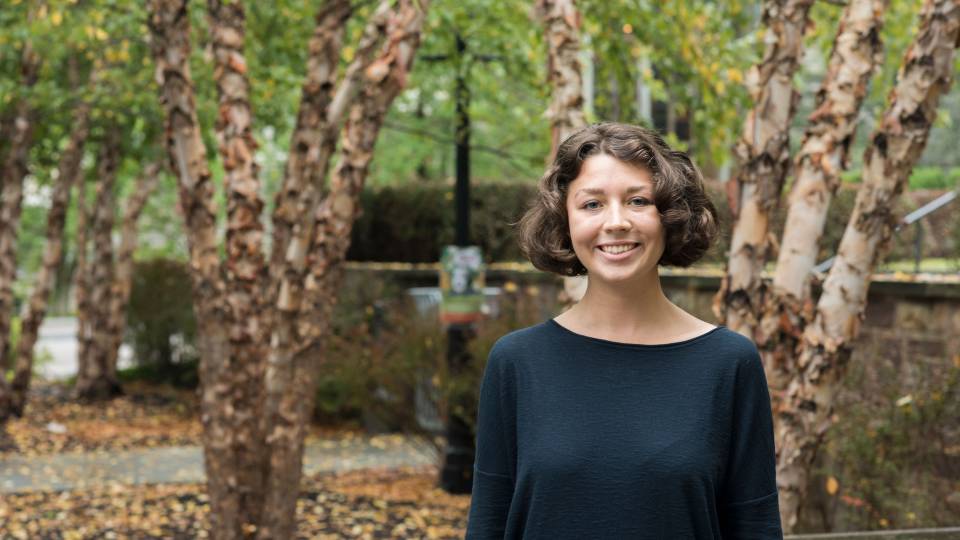Events marking the installation of the John Witherspoon statue will begin at 4:30 p.m. Friday, Nov. 9, with a public lecture by Scottish sculptor Alexander Stoddart in McCosh 46. He will discuss his work on the project in a lecture titled "John Witherspoon: Man and Statue." The statue will be unveiled in a ceremony at 4:15 p.m. Saturday, Nov. 10, at the site east of East Pyne. Stoddart and officials from Princeton and Paisley universities will speak. Some descendants of Witherspoon also are expected to attend. Following the unveiling, a bagpiper will lead participants to Maclean House for a reception.
A student of John Witherspoon, the president of Princeton University during the Revolutionary War, once claimed that the Scotsman had more "presence" than any man he had known other than George Washington.
Witherspoon's boundless presence will again be felt on the campus when a 10-foot-tall bronze statue is unveiled in ceremonies Saturday, Nov. 10 (see above).
The statue, by highly acclaimed Scottish sculptor Alexander Stoddart, is the twin of a piece installed last June at the University of Paisley in Scotland. The artworks are intended to honor Witherspoon's contributions in this country and in Scotland as a patriot, president and preacher and to commemorate the connections between the two communities through Witherspoon.
Witherspoon, who lived from 1723 to 1794, was a graduate of the University of Edinburgh. He became widely known in Scotland as a leader of the Popular Party in the Church of Scotland, in which he was an ordained minister. He was installed as the pastor at Paisley, Scotland, in 1757. The author of pamphlets dealing with controversial religious subjects, he gained wide recognition for his works in Scotland and in the American colonies.
The trustees of what was then the College of New Jersey elected him president in 1766, but he declined their offer. He was eventually persuaded to reconsider, and moved his family to Princeton in 1768. He served as the College's sixth president until his death.
Witherspoon's administration is considered a major turning point in the life of the College. He bolstered the school's educational program, advocating the need for a broadly educated clergy. He encouraged the teaching of both politics and religion. He supported the national cause of liberty and became a leading member of the Continental Congress.
Largely because of Witherspoon's efforts, Princeton became known as the "seedbed" of the revolution. He was the only clergyman and the only college president to sign the Declaration of Independence. Six months later, the College was the site of a strategic victory when Washington surprised the British in the Battle of Princeton.
The recent effort to recognize Witherspoon began in November 1998, when a delegation from Paisley visited Robert Durkee, Princeton's vice president for public affairs. The delegation proposed the two statues, and University administrators decided the project was a suitable memorial to an exceptional man.
"Witherspoon is one of the most towering figures in Princeton's history," said Durkee. "The creation of such a compelling sculpture by a gifted artist presented us with a tangible way to remind all who live, work and visit on this campus of the pivotal role Witherspoon played in shaping this University and this nation."
The project was a joint undertaking by the two universities. Stoddart, who began sculpting the statues in 1999, lives and works in Paisley. Born in Edinburgh and educated at the Glasgow School of Art, he started his career as a sculptor in 1983. His monumental works feature prominently in the major cities of Scotland and in the collections of the National Galleries of Scotland.
He has designed the Witherspoon statue in the "heroic realist" manner, a style in which many late 19th- and early 20th-century American sculptors excelled. Heroic realist projects convey messages through the clever use of everyday objects, Stoddart explained.
He depicts Witherspoon in "vigorous" middle age, preaching at a symbolic lectern on which an open Bible rests. The shaft of the lectern is in the form of a "fasces," a bundle of rods inset with rising arrows bound by two horizontal tapes. The fasces represents Witherspoon's activities as a statesman. The Bible and Witherspoon's pose portray his role as a clergyman. An eagle, positioned at the top of the fasces and under the Bible, symbolizes both the state and the church.
A reminder of freedom
"I hope the statue, with its twin in Paisley, will attest to the power of both communities to think of their pasts, during which exceptionally brave and visionary individuals saw to it that freedoms we tend to take for granted were seeded and nurtured," Stoddart said.
"All the people who worked on this complex project -- even only at the most technical level -- have found themselves growing wistful over this statue," he continued. "Since the great catastrophes in New York, Pittsburgh and Washington, the concentration of mind has increased, so that now this image of John Witherspoon comes from the Scots to the Americans with re-doubled assurances of friendship and community."
Stoddart modeled the statue in two tons of clay and made a plaster cast of the model, from which the foundry cast two copies in bronze -- one for Paisley, the other for Princeton. The molten bronze was poured into sand molds for the large body areas, while the head and more detailed parts were cast using the "lost wax" process.
The statue is 10 feet 2 inches tall and weighs about 2,750 pounds. It will reside atop a 7-foot-7-inch plinth, for a total height of nearly 18 feet. The plinth, which has a concrete core, granite base and Indiana limestone body, has been designed by Princeton architect Jeffery Clarke.
"It is based on designs for typical 18th-century pedestals -- I thought that would befit the image of an 18th-century man," Clarke said. "It will have his name, birth and death dates on the front and will have interpretive bronze plaques on the other three sides entitled 'Patriot,' 'Preacher' and 'President' -- the three roles ascribed to him that are most important to the University and to Princetonians."
The statue arrived by ship in Newark on Oct. 15, and, after clearing customs, traveled by truck to the Princeton campus. Its home will be on the east side of East Pyne, where it will face the University Chapel.
The statue at the University of Paisley stands at the entrance to the campus. It was unveiled June 22 by Princess Anne in ceremonies attended by local officials, representatives of the American consulate and former Princeton President Harold T. Shapiro and his wife, Vivian.
"The unveiling of the identical statue some months ago was a proud occasion for Paisley and its people," said Alex MacLennan, assistant principal at the University of Paisley. "With this second dedication, we again have the opportunity to celebrate in bronze and stone the link that Witherspoon forged between Paisley and Princeton."
An independent film crew has been shooting the progress on the statues since Stoddart began his work and will be at Princeton for the unveiling. The documentary is intended for use on the BBC.
It will be another two years, though, before members of the Princeton community and visitors can enjoy Stoddart's sculpture. Because nearby East Pyne currently is being renovated, the statue will be encased in a protective plywood enclosure following the Nov. 10 ceremony for the duration of the construction. The project is expected to be completed in the summer of 2003.
Contact: Marilyn Marks (609) 258-3601
